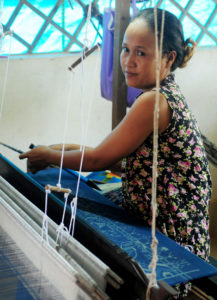Author: Magali Berthon
In celebration of the third annual New York Textile Month, members of the Textile Society of America will author Object of the Day for the month of September. A non-profit professional organization of scholars, educators, and artists in the field of textiles, TSA provides an international forum for the exchange and dissemination of information about textiles worldwide.
Hol pidan is a Cambodian term which designates a style of traditional silk hanging that was especially common in the Southern part of Cambodia. These four-meter long pictorial textiles were hung on Buddhist temples’ ceilings above the main Buddha statue. Until the early 1970s and before the rise of the Khmer Rouge, women in villages would weave hol pidan textiles and offer them to the nearest pagoda or monastery. In a country deeply rooted in Theravada Buddhism, which was established as state religion since the thirteenth century, weaving and donating these specific type of textiles was a way to make merit. These large hangings displayed Buddhist imagery and often depicted scenes of Vessantara Jataka, the story of the Buddha’s past lives. The hol pidan in Cooper Hewitt’s collection represents the Three Worlds, a popular theme of the Buddhist cosmology. Inhabited by mythical and auspicious creatures, the textile is divided into three bands representing three kingdoms coexisting in harmony. One can distinguish hell in the lower part, earth at the center, and heaven in the top part. The underworld displays confronted figures of mythical lions and flowering trees surrounded by birds. And the middle section showcases royal elephants facing a pagoda with a high spire piercing through the top section in the heavens.
The production of this type of rich polychromic textiles requires the talent of the most skilled weavers. Following the painstaking process of weft ikat, they first have to stretch the weft yarn on a wood frame and patiently tie small sections with strips of banana leaves before immersing the bundle of silk in a dye bath. Through successive rounds of tying and dyeing in baths of deep red, bright yellow, and dark blue, the weavers eventually achieve the desired pattern which appears on the weft threads. Once this stage is completed, the yarn is transferred on sets of spools and woven on the loom as a twill weave.

Weaver following a training program in pidan weaving at Caring for Young Khmer, Takeo Province, Cambodia (2017), Photo: Magali An Berthon
In the present day, while the finest examples of hol pidan textiles have been dispersed in museum collections all over the world, the practice itself has become quite rare in Cambodia. A handful of non-profit organizations such as Caring for Young Khmer or the Institute for Khmer Traditional Textiles have been encouraging weavers to perpetuate this technique by providing training programs and selling their products to tourist and expatriate customers. These artifacts have become decorative commodities shifting from their original religious function grounded in Cambodia’s rural life.
Magali An Berthon is a French Vietnamese textile designer, researcher and documentarist focusing on Southeast Asian textiles, local craft cultures, and sustainable processes. She is currently a PhD candidate in History of Design at the Royal College of Art in London researching the dynamics of silk heritage in contemporary Cambodia.

One thought on “Hol Pidan: An Otherworldly Cambodian Experience”
Amee on August 7, 2023 at 11:14 am
Hi, doing a college research. found your article very informative. Would like to know if Hol Pidan existed before the 17th century.